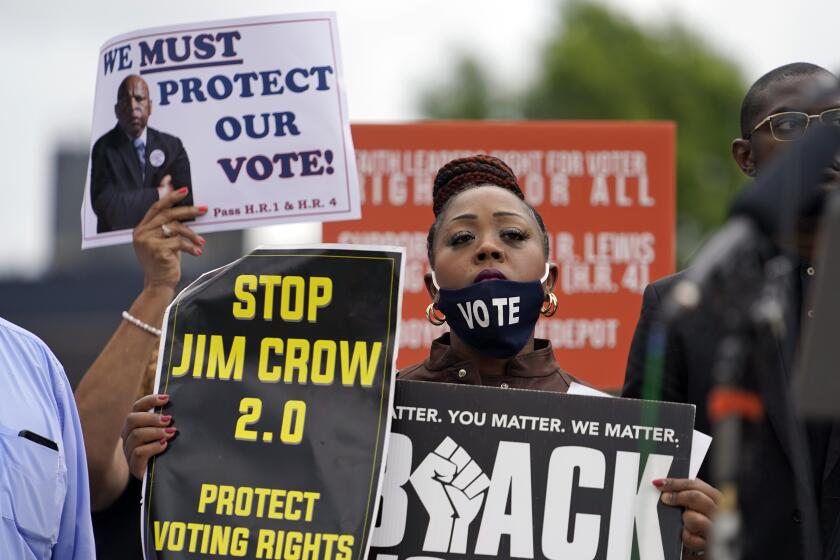Young Middle America Lags Under Reagan : Are You Better Off? Yes, if You’re Female or Elderly
George Bush, borrowing freely from Ronald Reagan, contends that in the 1988 election there is “one central question” that dominates: “Are you better off today than you were eight years ago?”
When Reagan, toward the end of his 1980 campaign against Jimmy Carter, asked, “Are you better off than you were four years ago?” the answer for most Americans was a clear “no.” Nearly all families had lost ground in the inflationary spiral of the late 1970s and the brief 1980 recession.
In a speech on Friday to the Town Hall of Los Angeles, Bush declared that the answer to his question was just as clear cut--”a resounding ‘yes’ . . . for the vast majority of Americans.” The vice president then rattled off a barrage of statistics about income, interest rates, housing and inflation designed to prove his point.
But, when Americans ask themselves today whether they are better off than they were when Reagan took office in 1981, it is actually a multiple-choice question, and the answers are far more complicated.
There is no doubt that, in the last eight years, most American families regained much of their lost ground. In contrast to the period from 1977 to 1981, when the average family’s income, adjusted for inflation, briefly rose but then fell overall by about 7.5%, the typical family income has increased by more than 10% since 1981.
However, family incomes today are only slightly ahead of their earlier peaks during the 1970s. Last year, the median family income--half the families in America earned more and half earned less--was almost $31,000. That is up sharply from the $27,977 median in 1981 but still barely more than the typical family’s income, in today’s dollars, of $30,730 in 1978 and $30,820 in 1973.
Even more important, despite the general prosperity of the 1980s, a lot of Americans have been left behind.
“Most people are better off than they were eight years ago, but that only begins to answer the question,” said Frank Levy, a University of Maryland economist whose book, “Dollars and Dreams,” is the most detailed examination of income trends of the last two decades.
“The rising tide did not lift all boats,” Levy said. “Look at younger workers, guys with only a high school education, single mothers, those who did not already own their own home. They didn’t do well in the bad economy of the 1970s and early 1980s, and many of them did no better or even worse once the recovery began.”
Bad Years for Baby Boomers
In general, despite the media focus on yuppies and the comfortable life styles celebrated in the television show “thirtysomething,” the 1980s have not been good years for the huge baby boom generation that entered the work force in droves in the 1970s and 1980s.
Hit particularly hard were younger men without a college education, who found traditional blue-collar jobs disappearing in the 1981-1982 recession and the painful years of industrial restructuring that ensued. And, despite the increase in two-earner families, young people have found it harder to buy a home than their parents did.
“Middle America is a changing neighborhood,” University of Massachusetts Prof. Ralph Whitehead said. “Its first generation has pulled up stakes, and a new generation is struggling to move into its place. The new Middle Americans feel culturally better off than their parents, but, at the same time, their material lives are less secure. Archie and Edith Bunker are giving way to Meathead and Gloria.”
Dan Bailes of La Habra, a bus driver for the Orange County transit system, lives in Whitehead’s Middle America.
Wife Must Work
“A decade ago, it seemed that my job paid pretty good money compared to the others that were available,” said the 39-year-old Bailes. “But those days are long gone. If my wife wasn’t working, I’d be in a lot of trouble because I’ve become worse off over the last eight years. There’s no way on God’s green earth you can get by on one income today.”
Although his family income is fairly decent by national standards, Bailes is convinced that he is slipping further and further behind.
“I sure didn’t expect to be driving a bus for 12 years,” said Bailes, a graduate of the University of California at Riverside. “It just seemed to happen.”
And his income has been squeezed as labor unions such as his have lost clout in the 1980s. “Under Reagan, there hasn’t been a lot of money for public transit, so we’ve been limited by very meager wage increases,” Bailes said. “And our union was pretty effectively broken last year after a two-week strike failed.”
Bailes’ experience is typical of younger blue-collar workers, most of whom did poorly throughout the 1970s and formed the core of the so-called Reagan Democrats out of dissatisfaction with the performance of the economy under Carter. But they actually lost even more ground in the 1980s.
Baby boomers like Bailes--those born during the high-birth years of 1946 through 1964--were dealt a one-two punch. Their incomes suffered because so many of them were competing against one another for jobs. And, on the expenditure side of their family budgets, they were hurt by the escalation in the cost of homeownership caused by a surge in home values followed by sharply higher mortgage rates.
Bailes’ plight has been made all the worse by the soaring cost of housing in Southern California. He said his family had to move from a southeast Los Angeles County suburb “because the gangs were getting so bad, but now we’re saddled with home payments that are just out of sight.”
At least Bailes has a home of his own. During the 1980s, the percentage of young families that own their homes dropped for the first time since the Great Depression. For people from 30 to 39 years of age, for example, homeownership fell from 61% in 1980 to 53% in 1987.
As interest rates have come down in the wake of the recession, it has become easier for the average family to afford a home again. Seven years ago, the after-tax monthly cost of living in a newly acquired median-priced home took a hefty 36.3% of the typical family’s income. Today, it requires 22.5%. But homeownership remains a difficult goal for many young families because escalating home prices have caused down payments to rise much faster than incomes.
Younger Workers Catching Up
Prospects for younger male workers may finally be starting to improve, though. In the last couple of years, as an export boom has cut into the nation’s trade deficit, manufacturing workers, particularly those concentrated in the nation’s revitalized Rust Belt, have been starting to catch up with the rest of the country.
In contrast to younger men, the gains of working women represent one of the unheralded success stories of the 1980s. Women have significantly narrowed the pay gap with men as new jobs in the booming service industries have opened up opportunities for them throughout the nation.
“I’m doing better than I expected,” said Elizabeth Smesny, who manages a bookstore in a suburb of Ft. Worth, Tex. “This is not a rich neighborhood, and the state economy is in the pits; but, as long as books keep selling, I’m going to make out just fine.”
From 1979 to 1986, working women of all ages and nearly all educational levels achieved solid earnings gains. Adjusted for inflation, the incomes of college-educated women surged ahead nearly 20%. The only exception to the broad gains were high-school dropouts, many of whom were trying to rear children alone on their meager incomes.
At the same time, many more women are working today than before. Of the 15 million jobs added to the U.S. economy since 1981, two-thirds were filled by women.
The elderly, who are disproportionately female, also have prospered in the 1980s. Buttressed by a Social Security system designed to keep up with rising prices, they steadily improved their incomes throughout the 1980s at a much faster pace than inflation.
One in four elderly Americans lived in poverty in 1970, a ratio that declined to one in eight last year. For the first time in history, poverty is rarer among the elderly than the rest of the population.
Meanwhile, a solid black middle class has continued to emerge from the ghettos. Since 1981, the number of two-earner black families increased 15% and the median income for black families with two earners advanced to almost $40,000. “This is the first secure generation of middle-class blacks,” said Bart Landry, a University of Maryland sociologist.
Among white men, older men have generally fared better than younger ones since 1973, primarily because union contracts and seniority practices have sheltered many of them from the massive industrial cutbacks in the nation’s manufacturing firms.
And older men were more likely to have already bought a home before housing prices and interest rates soared in the 1970s. Except in such regions as the Southwest oil patch, they were generally protected against economic downturns.
“People who had already attained the American Dream found that they had certain protections: job seniority and a fixed-payment mortgage that kept housing costs under control,” Levy explains in his book. “But families that had not yet reached the dream saw its price escalate rapidly.”
Meanwhile, the well-educated increased their earnings edge over those with fewer credentials. In the middle of the 1970s, a 30-year-old with a college degree could expect to earn 15% to 20% more than a high school graduate; now the gap is about 50%.
Under these circumstances, many younger families have tried to maintain a higher standard of living by having fewer children, making both parents breadwinners and going deeper into debt.
With the exception of the plunge in inflation, however, it is hard to argue that the overall economic policies consciously pursued by either Reagan or Carter had much effect on living standards. Most of the shifts in incomes seem the result more of demographic trends and the business cycle than of changes in Washington.
Even the campaign against inflation was waged mostly by Federal Reserve Board Chairman Paul A. Volcker, who imposed the discipline of tight money and high interest rates beginning in 1979. Most economists contend that Reagan deserves credit for backing those controversial policies, which caused the deep 1981-82 recession, although it was Carter who appointed Volcker in 1979.
The collapse of inflation laid the groundwork for the long economic expansion that began six years ago and shows no signs of ending.
“The pain we endured from 1979 through 1982 created so much slack in the economy that we have been able to grow for a very long time and will continue to grow until inflation accelerates enough to undermine the expansion again,” said David A. Levine, a Wall Street economist with Sanford C. Bernstein & Co.
Unemployment has fallen to 5.3%, the lowest level in 14 years. But many economists are worried that the jobless rate is nearing the point at which pressures for pay hikes may outpace gains in productivity, gradually reviving inflation.
Where Carter’s and Reagan’s policies have made a difference is in contributing to a growing income inequality.
From 1977 to 1988, the after-tax income of the poorest one-tenth of the population fell by 10% after inflation, according to the Congressional Budget Office. At the same time, the income of the richest one-tenth rose by a whopping 27%.
During the “stagflation” of the Carter years, those at the bottom of the ladder saw their job prospects decline, and they had no assets to grow in value with inflation. Then Reagan’s welfare cuts directly hurt the poor, and the tax changes he pushed through Congress in 1981 and 1983 benefited the rich far more than others.
Increase in Efficiency
“Supply-side” economists are probably correct in saying that the dramatic decline in tax rates for upper-income individuals--to 28% from 70%--has boosted economic efficiency. It is hard to have a rich society without allowing people to get richer.
But, by cutting income taxes sharply while dramatically raising payroll taxes for Social Security and Medicare, the government has left most families paying a slightly larger share of their income in federal taxes than they did just before Reagan took office.
The richest 10% of the population saw their overall federal tax burden decline by 6.4% before the tax overhaul went into effect last year, but the poorest 10% were subjected to a 20% increase.
HOW EARNINGS CHANGED OVER TWO DECADES
Changes in individual earnings for men and women who work full-time, adjusted for inflation.
Age 25-34 Age 35-44 Age MEN 1973-79 1979-86 1973-79 1979-86 1973-79 1-3 years high school -7% -14% -11% -7% -2% 4 years high school -6 -10 -3 -4 -3 1-3 years college -4 -3 -8 +1 -9 4 years college -9 +9 -6 +1 -5 4+ years college -6 +12 -7 +4 -7 WOMEN 1-3 years high school 0% 0% +3% -4% +1% 4 years high school +2 +1 0 +9 0 1-3 years college -1 +5 +1 +12 0 4 years college -3 +16 -8 +23 -7 4+ years college -5 +18 -6 +13 +13
45-54 MEN 1979-86 1-3 years high school -3% 4 years high school -1 1-3 years college +4 4 years college +6 4+ years college +10 WOMEN 1-3 years high school -1% 4 years high school +6 1-3 years college +10 4 years college +16 4+ years college +8
Source: Frank Levy, University of Maryland, based on calculations from Census Bureau data. Does not conform exactly to presidential terms but gives the most revealing indication of underlying trends in the 1970s and the 1980s.
More to Read
Get the L.A. Times Politics newsletter
Deeply reported insights into legislation, politics and policy from Sacramento, Washington and beyond. In your inbox three times per week.
You may occasionally receive promotional content from the Los Angeles Times.






